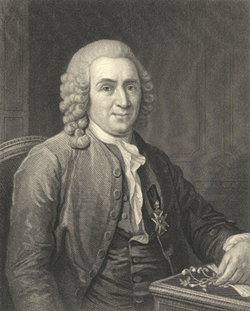Past Exhibitions
Order from Chaos: Linnaeus Disposes
28 April – 31 July 2002
Swedish botanist Carolus Linnaeus (1707–1778) devised comprehensive, consistent schemes for classifying and describing plants and animals and for assigning two-word scientific names to all species, thus laying the foundations of modern biological taxonomy. Pages of manuscripts, plant portraits, portraits of botanists and rare books from the Institute's Archives, Art Department and Library, including the Strandell Collection of Linnaeana, highlighted the achievements of Carolus Linnaeus in the broader context of botany over two millennia.
The first section of the exhibit set the stage by showing the importance of classical science in shaping subsequent science in the West; the continuity of science through the cultures of the Mediterranean area; the recovery of ancient writings during the Renaissance and the resulting scientific crisis; and the beginnings of a search for a new botanical system. Four pages of a 13th-century Arabic manuscript were displayed here for the first time at Hunt Institute, along with several leaves from a 15th-century incunabulum herbal, Gart der Gesundheit, and a number of books from the 15th and 16th centuries.
The second section showed how Linnaeus drew on the work of his predecessors and contemporaries and developed a coherent system for describing and naming organisms that has continued into the present. It also showed how Linnaeus' students traveled the globe to explore and collect information and specimens, and how aspects of the Linnaean system have enabled amateurs and professionals worldwide to identify, name and describe plants for more than two centuries. On display were key works by Linnaeus including his Species Plantarum (1753) and Genera Plantarum (1754), which are the starting points for botanical binomial nomenclature. Also displayed were books by some of his contemporaries and students, along with portraits and biographical information, and selected examples of post-Linnaean works showing how aspects of his system have been used from the 18th century into the present day.
The exhibition coincided with an invitational workshop, Linnaean Nomenclature in the 21st Century: A Workshop to Integrate Traditional Nomenclature and Phylogenetic Classification, being held at the Institute on 26–28 June 2002. Co-sponsored by the Hunt Institute and the Department of Botany, National Museum of Natural History, Smithsonian Institution, the workshop developed specific recommendations for a workable integration of traditional Linnaean nomenclature and modern phylogenetic classification such that the advantages of both were retained.
Carolus Linnaeus (1707–1778), engraving by C. E. Wagstaff after an oil painting by L. Pasch after an original by A. Roslin, 1775, at the Royal Swedish Academy of Sciences, Stockholm, for John Eadie (1810–1876) and John Francis Waller (1810–1894), The Imperial Dictionary of Universal Biography: A Series of Original Memoirs of Distinguished Men of All Ages and All Nations (London, W. Mackenzie, 1857, vol. 3, after p. 206), HI Archives portrait no. 20 and HI Library call no. L15 I34.

![<p>Caroli Linnaei Classes S. Literae [characters used in Linnaeus' classification system], engraving after an engraving and original by Georg Dionys Ehret (1708–1770), 1736, for Carolus Linnaeus (1707–1778), <em>Genera Plantarum</em> (Lieden, 1737, after p. [14] following table Clavis Classium), Strandell Collection of Linnaeana no. 5376, HI Library.</p>](/admin/uploads/hibd-ehret-linnaeus-classification.jpg)
